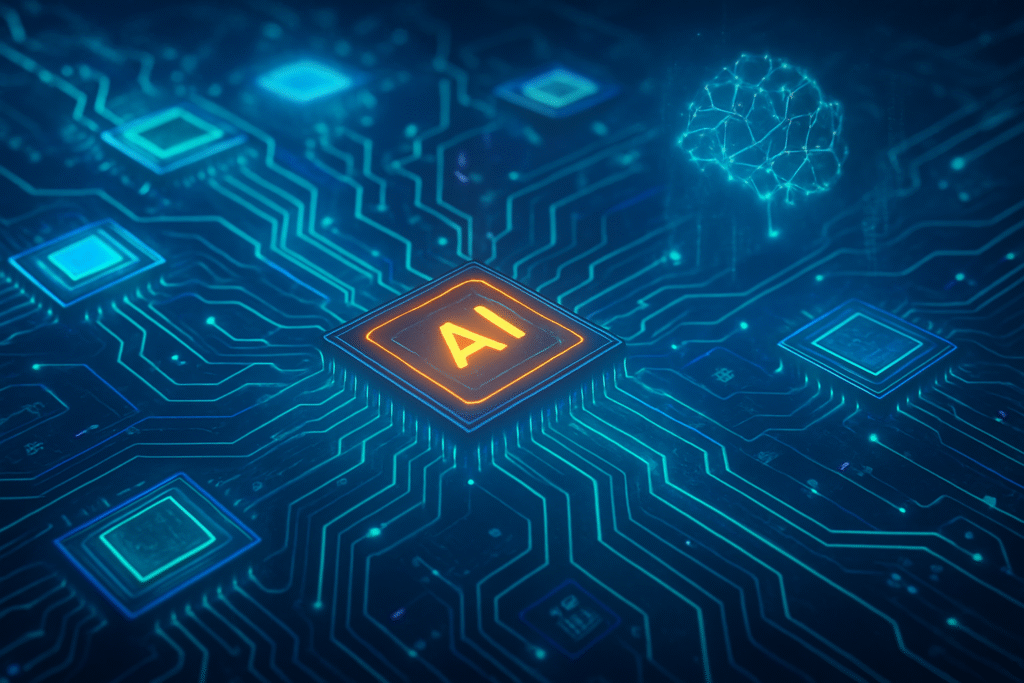
New York, NY – October 10, 2025 – Despite a landscape frequently marked by geopolitical tensions and supply chain complexities, the semiconductor industry is on a trajectory of sustained growth and resilience. This optimistic outlook comes from Joshua Buchalter, a senior analyst at TD Cowen, who foresees the sector continuing to "grind higher," driven by fundamental demand for compute power and the accelerating expansion of artificial intelligence (AI). Buchalter's analysis offers a reassuring perspective for investors and industry stakeholders, suggesting that underlying market strengths are robust enough to navigate ongoing challenges.
The immediate significance of this prediction lies in its counter-narrative to some prevailing anxieties about the global economy and trade relations. Buchalter’s steadfast confidence underscores a belief that the core drivers of semiconductor demand—namely, the insatiable need for processing power across an ever-widening array of applications—will continue to fuel the industry's expansion, cementing its critical role in the broader technological ecosystem.
Deep Dive into the Pillars of Semiconductor Expansion
Buchalter's positive assessment is rooted in a confluence of powerful, simultaneous growth factors that are reshaping the demand landscape for semiconductors. Firstly, the increasing global user base continues to expand, bringing more individuals online and integrating them into the digital economy, thereby driving demand for a vast array of devices and services powered by advanced chips. Secondly, the growing complexity of applications and workloads means that as software and digital services evolve, they require increasingly sophisticated and powerful semiconductors to function efficiently. This trend is evident across enterprise computing, consumer electronics, and specialized industrial applications.
The third, and perhaps most impactful, driver identified by Buchalter is the expanding use cases for Artificial Intelligence. AI's transformative potential is creating an unprecedented demand for high-performance computing, specialized AI accelerators, and robust data center infrastructure. Buchalter highlights the "AI arms race" as a critical catalyst, noting that the demand for compute, particularly for AI, continues to outstrip supply. This dynamic underpins his confidence in companies like NVIDIA (NASDAQ: NVDA), which he does not consider overvalued despite its significant market capitalization, given its pivotal role and growth rates in the global compute ecosystem.
In terms of specific company performance, Buchalter has maintained a "Buy" rating on ON Semiconductor (NASDAQ: ON) with a target price of $55 as of September 2025, signaling confidence in its market position. Similarly, Broadcom (NASDAQ: AVGO) received a reiterated "Buy" rating in September 2025, supported by strong order momentum and its burgeoning influence in the AI semiconductor market, with expectations that Broadcom's AI revenue growth will more than double year-over-year in FY26. However, not all outlooks are universally positive; Marvell Technology (NASDAQ: MRVL) saw its rating downgraded from "Buy" to "Hold" in October 2025, primarily due to limited visibility in its custom XPU (AI accelerators) business and intensifying competition in key segments. This nuanced view underscores that while the overall tide is rising, individual company performance will still be subject to specific market dynamics and competitive pressures.
Competitive Implications and Strategic Advantages in the AI Era
Buchalter's analysis suggests a clear delineation of beneficiaries within the semiconductor landscape. Companies deeply entrenched in the AI value chain, such as NVIDIA (NASDAQ: NVDA), are poised for continued dominance. Their specialized GPUs and AI platforms are fundamental to the "AI arms race," making them indispensable to tech giants and startups alike who are vying for AI leadership. Broadcom (NASDAQ: AVGO) also stands to benefit significantly, leveraging its robust order momentum and increasing weight in the AI semiconductor market, particularly with its projected doubling of AI revenue growth. These companies are strategically positioned to capitalize on the escalating demand for advanced computing power required for AI model training, inference, and deployment.
Conversely, companies like Marvell Technology (NASDAQ: MRVL) face heightened competitive pressures and visibility challenges, particularly in niche segments like custom AI accelerators. This highlights a critical aspect of the AI era: while overall demand is high, the market is also becoming increasingly competitive and specialized. Success will depend not just on innovation, but also on strong execution, clear product roadmaps, and the ability to secure follow-on design wins in rapidly evolving technological paradigms. The "lumpiness" of customer orders and the difficulty in securing next-generation programs can introduce volatility for companies operating in these highly specialized areas.
The broader competitive landscape is also shaped by governmental initiatives like the U.S. CHIPS Act, which aims to rebuild and strengthen the domestic semiconductor ecosystem. This influx of investment in wafer fab equipment and manufacturing capabilities is expected to drive substantial growth, particularly for equipment suppliers and foundries. While this initiative promises to enhance supply chain resilience and reduce reliance on overseas manufacturing, it also introduces challenges such as higher operating costs and the scarcity of skilled talent, which could impact the market positioning and strategic advantages of both established players and emerging startups in the long run.
Broader AI Landscape and Geopolitical Crossroads
Buchalter's optimistic outlook for the semiconductor industry fits squarely into the broader narrative of AI's relentless expansion and its profound impact on the global economy. The analyst's emphasis on the "increasing users, growing complexity of applications, and expanding use cases for AI" as key drivers underscores that AI is not merely a trend but a foundational shift demanding unprecedented computational resources. This aligns with the wider AI landscape, where advancements in large language models, computer vision, and autonomous systems are consistently pushing the boundaries of what's possible, each requiring more powerful and efficient silicon.
However, this growth is not without its complexities, particularly concerning geopolitical dynamics. Buchalter acknowledges that "increased tech trade tensions between the U.S. and China is not good for the semiconductor index." While he views some investigations and export restrictions as strategic negotiating tactics, the long-term implications of a bifurcating tech ecosystem remain a significant concern. The potential for further restrictions could disrupt global supply chains, increase costs, and fragment market access, thereby impacting the growth trajectories of multinational semiconductor firms. This situation draws parallels to historical periods of technological competition, but with AI's strategic importance, the stakes are arguably higher.
Another critical consideration is the ongoing investment in mature-node technologies, particularly by China. While Buchalter predicts no structural oversupply in mature nodes, he warns that China's aggressive expansion in this segment could pose a risk to the long-term growth of Western suppliers. This competitive dynamic, coupled with the global push to diversify manufacturing geographically, highlights the delicate balance between fostering innovation, ensuring supply chain security, and navigating complex international relations. The industry's resilience will be tested not just by technological demands but also by its ability to adapt to a constantly shifting geopolitical chessboard.
Charting the Course: Future Developments and Emerging Challenges
Looking ahead, the semiconductor industry is poised for several significant developments, largely fueled by the persistent demand for AI and the strategic imperative of supply chain resilience. Near-term, expect continued substantial investments in data centers globally, as cloud providers and enterprises race to build the infrastructure necessary to support the burgeoning AI workloads. This will translate into robust demand for high-performance processors, memory, and networking components. The "AI arms race" is far from over, ensuring that innovation in AI-specific hardware will remain a top priority.
Longer-term, the rebuilding of the semiconductor ecosystem, particularly in the U.S. through initiatives like the CHIPS Act, will see substantial capital deployed into new fabrication plants and research and development. Buchalter anticipates that the U.S. could meet domestic demand for leading-edge chips by the end of the decade, a monumental shift in global manufacturing dynamics. This will likely lead to the emergence of new manufacturing hubs and a more diversified global supply chain. Potential applications on the horizon include more pervasive AI integration into edge devices, advanced robotics, and personalized healthcare, all of which will require increasingly sophisticated and energy-efficient semiconductors.
However, significant challenges need to be addressed. As Buchalter and TD Cowen acknowledge, the drive to rebuild domestic manufacturing ecosystems comes with higher operating costs and the persistent scarcity of skilled talent. Attracting and retaining the necessary engineering and technical expertise will be crucial for the success of these initiatives. Furthermore, navigating the evolving landscape of U.S.-China tech trade tensions will continue to be a delicate act, with potential for sudden policy shifts impacting market access and technology transfer. Experts predict that the industry will become even more strategic, with governments playing an increasingly active role in shaping its direction and ensuring national security interests are met.
A Resilient Future: Key Takeaways and What to Watch
Joshua Buchalter's analysis from TD Cowen provides a compelling narrative of resilience and growth for the semiconductor industry, driven primarily by the relentless expansion of AI and the fundamental demand for compute. The key takeaway is that despite geopolitical headwinds and competitive pressures, the underlying drivers for semiconductor demand are robust and will continue to propel the sector forward. The industry's ability to innovate and adapt to the ever-increasing complexity of applications and workloads, particularly those related to AI, will be paramount.
This development holds significant importance in AI history, as it underscores the symbiotic relationship between advanced silicon and AI breakthroughs. Without continuous advancements in semiconductor technology, the ambitious goals of AI—from fully autonomous systems to human-level intelligence—would remain out of reach. Buchalter's outlook suggests that the foundational hardware enabling AI is on a solid footing, paving the way for further transformative AI applications.
In the coming weeks and months, industry watchers should pay close attention to several indicators. Monitor the progress of new fabrication plant constructions and the efficacy of government incentives in attracting talent and investment. Observe the quarterly earnings reports of key players like NVIDIA (NASDAQ: NVDA), Broadcom (NASDAQ: AVGO), and ON Semiconductor (NASDAQ: ON) for insights into order momentum and revenue growth, especially in their AI-related segments. Furthermore, any developments in U.S.-China trade relations, particularly those impacting technology exports and imports, will be crucial to understanding potential shifts in the global semiconductor landscape. The future of AI is inextricably linked to the health and innovation of the semiconductor ecosystem, making this sector a critical barometer for technological progress.
This content is intended for informational purposes only and represents analysis of current AI developments.
TokenRing AI delivers enterprise-grade solutions for multi-agent AI workflow orchestration, AI-powered development tools, and seamless remote collaboration platforms.
For more information, visit https://www.tokenring.ai/.






